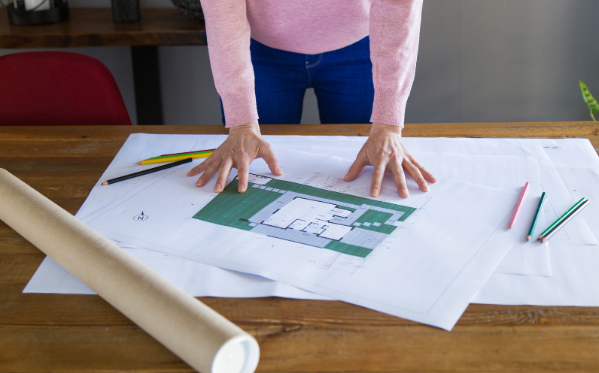Interior design requires a balance of creativity, functionality, and technical skills. While beginners may focus on colour schemes and furniture, professionals strategically design spaces to enhance comfort, efficiency, and aesthetics.
For those looking to master interior design, following a structured approach ensures seamless execution and professional-quality results. Whether working on residential spaces or commercial interior design in Singapore, this step-by-step guide covers everything from the fundamentals to expert techniques.
1. Understanding the Fundamentals of Interior Design
Every successful interior project begins with a strong understanding of core principles. Beginners must grasp the fundamental elements of design, including space planning, colour theory, balance, and proportion.
A well-designed space combines functionality and aesthetics. Understanding how light, texture, and materials interact helps create visually appealing and practical interiors. Studying successful design examples and observing commercial interior design consultants in action provides valuable insights into professional design strategies.
2. Mastering Space Planning for Functionality
Effective space planning determines how a space will function. Many beginners make the mistake of focusing on aesthetics without considering traffic flow, accessibility, or usability.
Professionals analyse room dimensions, movement patterns, and furniture placement to ensure a well-balanced layout. In commercial interior design in Singapore, designers optimise office layouts, retail displays, and hospitality spaces to improve efficiency. Mastering zoning, furniture scaling, and multi-purpose layouts is essential for functional design.
3. Choosing the Right Colour and Material Combinations
Colours and materials set the tone and personality of a space. Beginners often struggle with colour choices, leading to either overwhelming or uninspiring interiors.
Understanding colour psychology helps create welcoming, energetic, or calming spaces. In commercial spaces, brand identity influences colour selection, while in residential design, personal preference and mood enhancement play a role. Selecting durable, high-quality materials ensures that surfaces remain visually appealing and long-lasting.
4. Enhancing Interiors With Proper Lighting Design
Lighting is often overlooked by beginners, yet it impacts mood, productivity, and visual appeal. Many spaces suffer from insufficient or overly harsh lighting, reducing comfort and efficiency.
Professional designers use layered lighting techniques, combining ambient, task, and accent lighting to create depth and warmth. In commercial interior design in Singapore, effective lighting enhances brand visibility, employee performance, and customer engagement. Learning lighting placement and fixture selection significantly improves design quality.
5. Developing an Eye for Balance and Proportion
Interior design is about achieving harmony through proper scale, proportion, and symmetry. Beginners often place furniture or décor items without considering their size relative to the space, leading to imbalanced layouts.
Professional designers use the rule of thirds, focal points, and visual weight distribution to create aesthetic balance. Whether designing an office, retail space, or home, understanding scale and proportion prevents overcrowding or empty-looking rooms.
6. Incorporating Texture and Layering for Depth
Many beginners focus on furniture and wall colours while neglecting texture and layering, resulting in flat and lifeless interiors. Textured materials such as wood, fabric, stone, and metal add dimension to spaces, making them more visually dynamic.
Layering different materials creates contrast and interest. In commercial interior design, textured walls, rugs, and upholstery add luxury and depth to office spaces and hospitality interiors. Using a mix of soft and hard textures creates a well-balanced, inviting environment.
7. Maximising Storage and Organisation Solutions
Clutter disrupts design flow and functionality. Beginners often overlook storage planning, leading to messy, impractical spaces.
Professional designers integrate hidden storage, multifunctional furniture, and built-in shelving to maintain clean and structured interiors. In commercial interior design in Singapore, efficient storage solutions improve workplace productivity and space efficiency. Well-planned storage enhances usability without compromising aesthetics.
8. Studying Trends Without Losing Timeless Appeal
Following design trends keeps spaces fresh and modern, but relying too much on trends can lead to outdated interiors within a few years. Many beginners incorporate trendy elements without considering longevity, resulting in frequent redesigns.
Professionals blend timeless design elements with modern trends, ensuring a balanced approach. Commercial designers focus on brand-aligned aesthetics, while residential designers create adaptable spaces that evolve with time. Understanding which trends have lasting impact prevents design from feeling outdated too soon.
9. Learning From Commercial Interior Design Experts
Professional interior designers develop expertise through experience, research, and ongoing learning. Beginners looking to transition to advanced levels benefit from working alongside commercial interior design consultants to gain practical insights.
Observing real-life design projects, material selection processes, and client interactions helps bridge the gap between theory and practical application. Attending design workshops, studying successful projects, and working with an interior design service in Singapore provides valuable hands-on experience.
10. Refining and Executing a Design Like a Professional
Becoming a pro requires confidence in execution. Many beginners hesitate due to fear of making mistakes, but professionals refine their designs through sketches, mood boards, and 3D visualisations before implementation.
Executing a well-thought-out design plan involves selecting materials, coordinating contractors, and adjusting elements as needed. Whether handling a home renovation or commercial interior design in Singapore, applying professional-level planning, execution, and finishing touches elevates the final outcome.
Turn Your Interior Design Vision Into Reality
Mastering interior design requires a blend of creativity, planning, and technical skills. Following this step-by-step approach ensures that beginners gain confidence, refine their skills, and transition to professional-level execution.
For expert commercial interior design in Singapore, contact Le Createur Interior Design and bring your vision to life with professional guidance.


